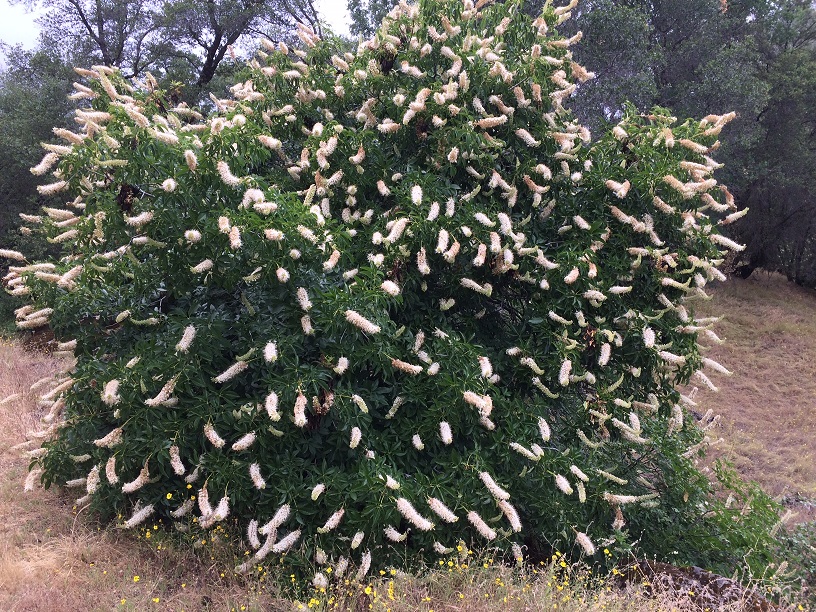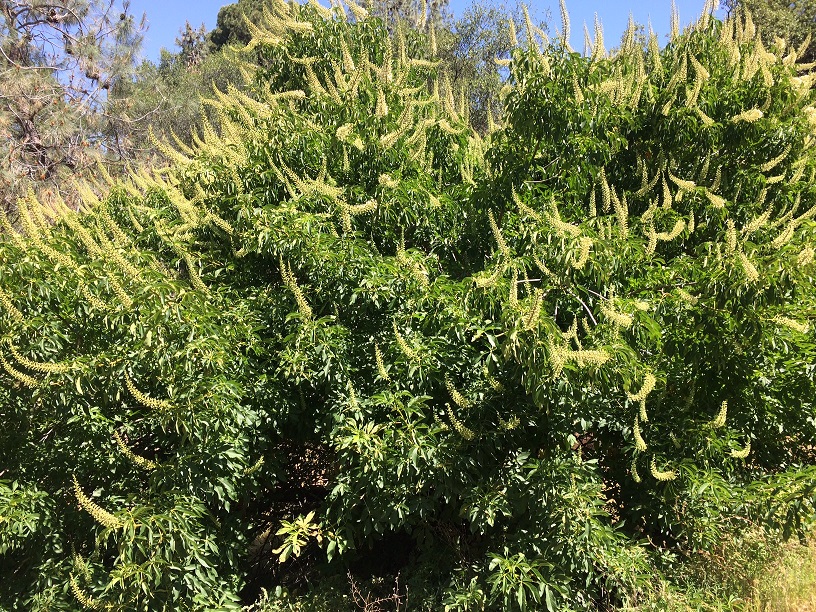

California Buckeye in flower, early spring. Photo copyright © 2020 Mariposa Native Plants
The California Buckeye is unique. A shrub or small tree, it is endemic to California. It is found in the northern Central Valley, the foothills surrounding the valley, and in the Coast Range from Santa Barbara north to almost the Oregon border. It leafs out early in the spring, becomes covered with large white flowers a bit later, and then abruptly drops its leaves, becoming dormant as soon as the summer heat descends. All parts of the Buckeye are poisonous to vertebrate animals, livestock, and human beings; it is safest to wear gardening gloves when handling the plant. For a broadleaf tree, it is extraordinarily long-lived: Some specimens are three centuries old, rivalling the pine and oak trees for longevity.
Buckeye leaves are a rich green color, palmately compound, with 5 to 7 leaflets. Very early in spring the flower bunches that emerge are somewhat pointed, like bent cones, and yellowish. But, later, when in full flower, the tree is easy to identify from the large, white or cream-colored, cylindrical flower heads. Also, a rounded shrub or small tree that appears to have died could well be a Buckeye that has dropped its leaves to conserve water for the remainder of the summer.

Yellowish Buckeye flowers in early spring. Photo copyright © 2020 Mariposa Native Plants
Elevation: foothills and coast mountains from sea level to 10,000 ft. (3,050m). Temperature: cold tolerant to -5°F (-20°C). Soil: variable; pH 4-8. In Mariposa County, the Buckeye is a good plant for native gardens in the foothills and lower mountains to 4,000 ft.
Buckeyes are fairly easy to transplant. This tree needs a site that is well-drained and has full or partial sunlight available. The roots are sensitive to disturbance; avoid breaking the root ball when planting from the container. The best times to plant them from a container is in the fall or winter, but after July the container shrubs are generally dormant and amenable to planting. After planting, drench the ground around the tree with water, making sure that the top of the root ball is level with ground around the tree. It is helpful to dig the hole down several inches below where the root ball will sit and fill it with loose, original soil, so as to better facilitate penetration by the Buckeye tap root. Water the tree one gallon once per week in the first summer, even if it has become dormant. Water no more than once per month, in the same amounts, in the second summer. Thereafter, no supplemental water should be required.
Aesculus californica nectar is toxic to non-native honeybees. If you have a fruit orchard or garden that depends upon European honeybees for pollination, it is best to not locate Buckeye trees in the vicinity. The flowers are not toxic to native pollinators, and they are an important source of nectar for many bumble bee and butterfly species.
In #1 and #2 containers, leafy in spring, but generally dormant after July.